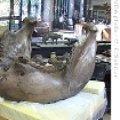The La Brea Tar Pits are asphalt deposits that contain the preserved remains of ancient animal and plant life, and they have shed light on life in the Ice Age since excavations started in 1913. This is the biggest find since then. The newly discovered fossils are collectively called Project 23, after the 23 large crates in which excavators placed the compacted fossils, soil and tar for later analysis.
Scientists have so far identified more than 700 specimens, including the skull of a prehistoric American lion and the bones of dire wolves, saber-tooth cats, ground sloths and bison. The most impressive find is the nearly complete skeleton of a huge Columbian mammoth.
Columbian mammoths are ancient cousins of the modern elephant, and they have been extinct since the end of the last Ice Age more than 10,000 years ago. This one, named Zed by scientist John Harris, has two intact tusks more than three meters long.
Harris is chief curator at the Page Museum, which houses treasures from the tar pits. He says only partial remains of mammoths were found at this site before, and Zed is largest ever found here. Zed was a male who stood three meters high at the hip. He was from 47 and 49 years old when he died, says Harris, judging from the skeleton.
"It's relatively complete," he said. "It's got nearly all of its bones, with the exception of the bones from one leg. It's got a skull, it's got its jaw and its teeth and its tusks. And to have something that complete from the tar pits is very unusual because normally in the tar pits, you'll find the bones all jumbled up together." Excavators discovered this cache of Ice Age remains as an old parking garage was being demolished to make way for a new one. So renovations could be completed, scientists pioneered a new technique to excavate the bones. The earth was removed intact and packed in oversized crates, which scientists will examine in a slow and careful process.
Christopher Shaw, the Page Museum's collections manager, says that plant and animal remains from the La Brea Tar Pits have already shown what life was like in Ice Age Los Angeles. The region was cooler and wetter than it is today. He says the new discoveries from 16 separate deposits may shed more light on the region's ecology and give us insight into subjects like climate change. "The 16 deposits hopefully will be 16 different ages and if that's the case, we will be able to see some kind of changes in the populations of plants and animals through time, through the last 40,000-45,000 years of time represented here at the tar pits," Shaw said. "So it's a very exciting prospect." The Page Museum's Aisling Farrell points to rows of shelves inside the museum, which contain specimens from the late Pleistocene Era, when these Ice Age creatures lived. She says it is a kind of reference library, consisting of fossils.
"We have a collection currently of about three and a half million specimens, and with our new project, we're estimated to double that collection," she said. As workers remove dirt and isolate specimens in the packing crates, others inside a so-called Fishbowl laboratory polish the jawbone and a tusk of the newly discovered mammoth. Curious schoolchildren watch through the windows.
Collections manager Shaw says they are sharing in the excitement that scientists feel as they uncover these remnants of ancient life.
"Because you come in every day not knowing what you're going to uncover, what you're going to discover that hasn't seen the light of day for 10,000, 20,000, 30,000, 45,000 years," he said. "So to me, that aspect has always been exciting." Scientists have barely scratched the surface of Project 23. They have started excavating three crates, including the largest, but are barely half a meter deep into the compacted soil, tar and animals remains in a crate that measures 50 cubic meters. They hope to catalogue the millions of fossils still in the packing crates over the next five years.
By Mike O'Sullivan Los Angeles 20 February 2009

